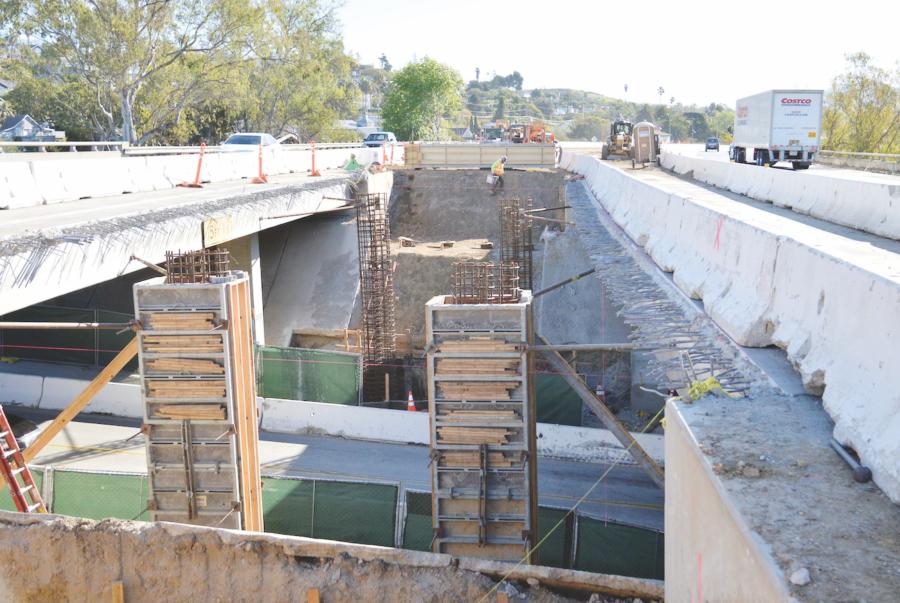“SB 1 and IIJA funding are helping rebuild and transform California’s transportation future and we are putting that investment to work to create a system that allows all of us to travel in an equitable, safe and sustainable way,” said Caltrans Director Tony Tavares.
(Caltrans photo)
The California Transportation Commission (CTC) recently invested nearly $2 billion into improving the state's transportation infrastructure while approving an additional $2.3 billion for future construction projects.
The nearly $2 billion allocation reflected more than $571 million in funding from the 2021 federal Infrastructure Investment and Jobs Act (IIJA) and more than $257 million in funding from Senate Bill (SB) 1, the Road Repair and Accountability Act of 2017.
The $2.3 billion consists of $1.75 billion representing the third funding cycle of programs established by SB 1 and $540 million in active transportation projects sponsored by local metropolitan planning organizations (MPOs), charting the course for future allocations.
"SB 1 and IIJA funding are helping rebuild and transform California's transportation future and we are putting that investment to work to create a system that allows all of us to travel in an equitable, safe and sustainable way," said Caltrans Director Tony Tavares.
The additional $1.7 billion for future investments cover three SB 1 competitive grant programs: $1.1 billion for the Trade Corridor Enhancement Program (TCEP); $507.4 million for the Solutions for Congested Corridors Program (SCCP); and $142.4 million for the Local Partnership Program (LPP). The programs included, for the first time, input from the new Interagency Equity Advisory Committee in the evaluation of projects. This funding round also marks the first cycle to incorporate all principles of the state's Climate Action Plan for Transportation Infrastructure.
The TCEP funding will go to 26 projects that support infrastructure improvements on corridors that carry a high volume of freight traffic with the goal of increasing efficiency, improving safety, and constructing an equitable and sustainable freight system. More than a third (10 of 26) of the TCEP projects include zero-emission technology components to support the deployment of a zero-emission freight transportation system and invest in light, medium and heavy zero-emission vehicle infrastructure. The SCCP funding will go to 10 projects to achieve a balanced set of transportation, environmental, and community access improvements to reduce congestion throughout the state. All 10 SCCP projects are multimodal, and five include active transportation improvements. The LPP funding will go to 11 projects that support counties, cities, districts, and regional transportation agencies where voters have approved fees or taxes dedicated solely to transportation.
TCEP Projects
- $140 million to fund the Otay Mesa East Port of Entry in San Diego, which will construct a new crossing at the California and Mexico border for personal and commercial vehicles;
- $70 million to fund the Fix 5 Cascade Gateway in Redding and Shasta County, which will restore and improve a large section of I-5 to allow more room to merge at the on- and off-ramps while helping reduce merging conflicts at multiple state routes that intersect in this area;
- $41.9 million to fund Southern California Hydrogen Fueling Facilities, which will build a network of heavy-duty hydrogen refueling stations for freight vehicles throughout Southern California. The six refueling stations will be located near highway interchanges and along heavily trafficked goods movement routes in Los Angeles, San Diego, San Bernardino and Riverside counties;
- $19.7 million to fund phase two of the I-80/San Pablo Dam Road Interchange Improvements, which will upgrade the overcrossing structure to current standards and provide improved pedestrian and bicycle facilities in the city of Richmond in Contra Costa County;
- $18.5 million to fund the I-5, State Route 15 and Harbor Drive 2.0 Project in the city of San Diego, which will improve freight throughput of about 1,600 more trucks per year by constructing all-day connected truck-only lanes and off-peak dedicated flex lanes, and other improvements to separate trucks from passenger traffic.
SCCP Projects
- $132.4 million to fund Santa Barbara U.S. Highway 101 Multimodal Corridor Project to increase both non-vehicular and vehicular mobility between Santa Barbara and Ventura counties;
- $50 million to fund the Capitol Corridor Regional Transit Improvement Project in Placer and Sacramento counties to increase mobility choices while improving freight capacity;
- $30 million to fund SMART Windsor Rail System Extension Project in Sonoma County, which will provide extended commuter rail services, non-motorized pathways, new short-line freight rail service opportunities and expanded broadband access;
- $20 million to fund the Los Angeles Metro Light Rail CORE Capacity & System Integration Project in Los Angeles County to improve transit service capacity to the Los Angeles International Airport.
LPP Projects
- $25 million to fund the Oakland Alameda Access Project and improve access between the cities of Oakland and Alameda;
- $15 million to fund the State Route 99/Caldwell Avenue Interchange, Safety and Multi-Modal Project in Tulare County, which will replace a stop-controlled interchange with two roundabouts and a new bridge with bike lanes and sidewalks to allow access across SR 99 that currently does not exist;
- $14.8 million to fund the San Mateo County Transit District (SamTrans) Emission Zero Project in the city of San Carlos, which will provide infrastructure and electrification improvements at SamTrans' Maintenance Facility;
- $6 million to fund the Urban Core Rehabilitation and Transportation Project in Ukiah, which will reconstruct local road and bicycle lanes, including replacement of water and sewer utilities and construction of ADA-accessible curb ramps;
- $2.4 million to fund the Foothill Boulevard Complete Street Project, which will add bicycle and pedestrian facilities in the city of Rancho Cucamonga in San Bernardino County.
Today's top stories




















